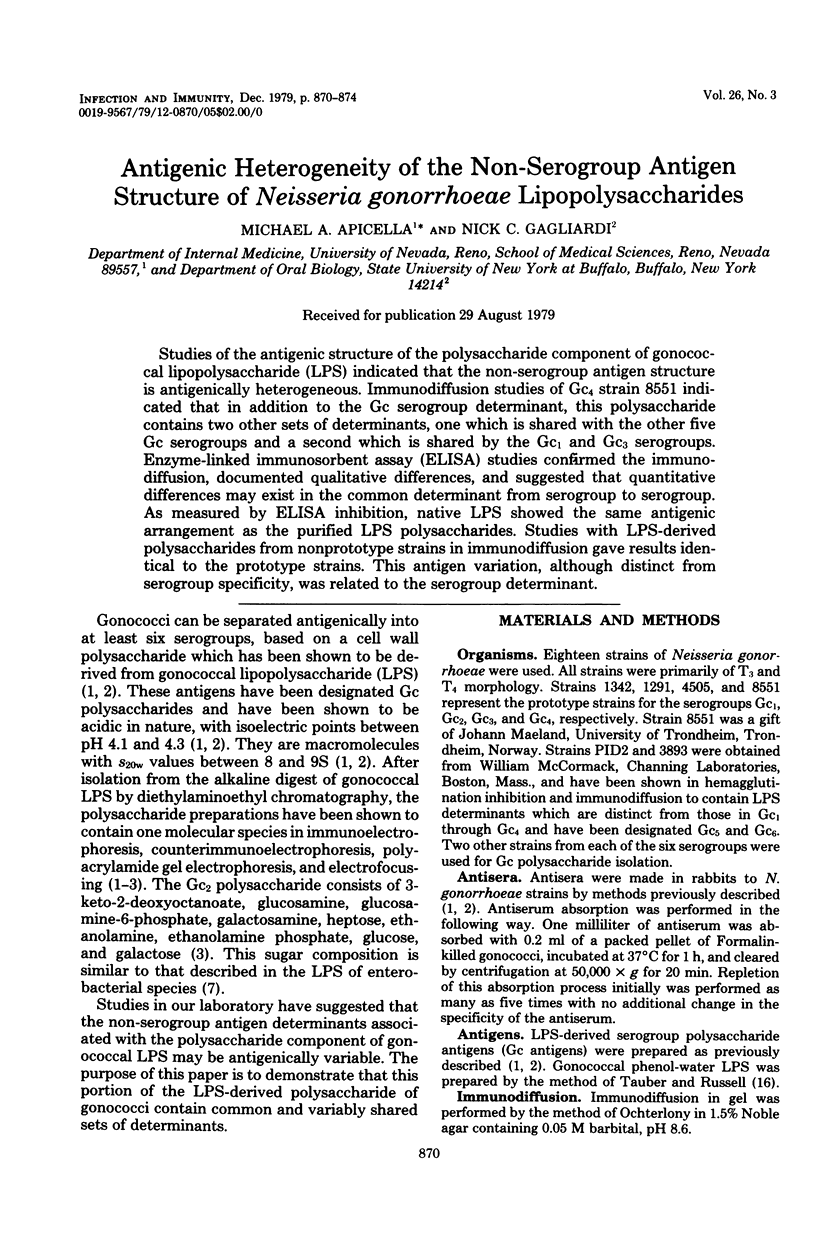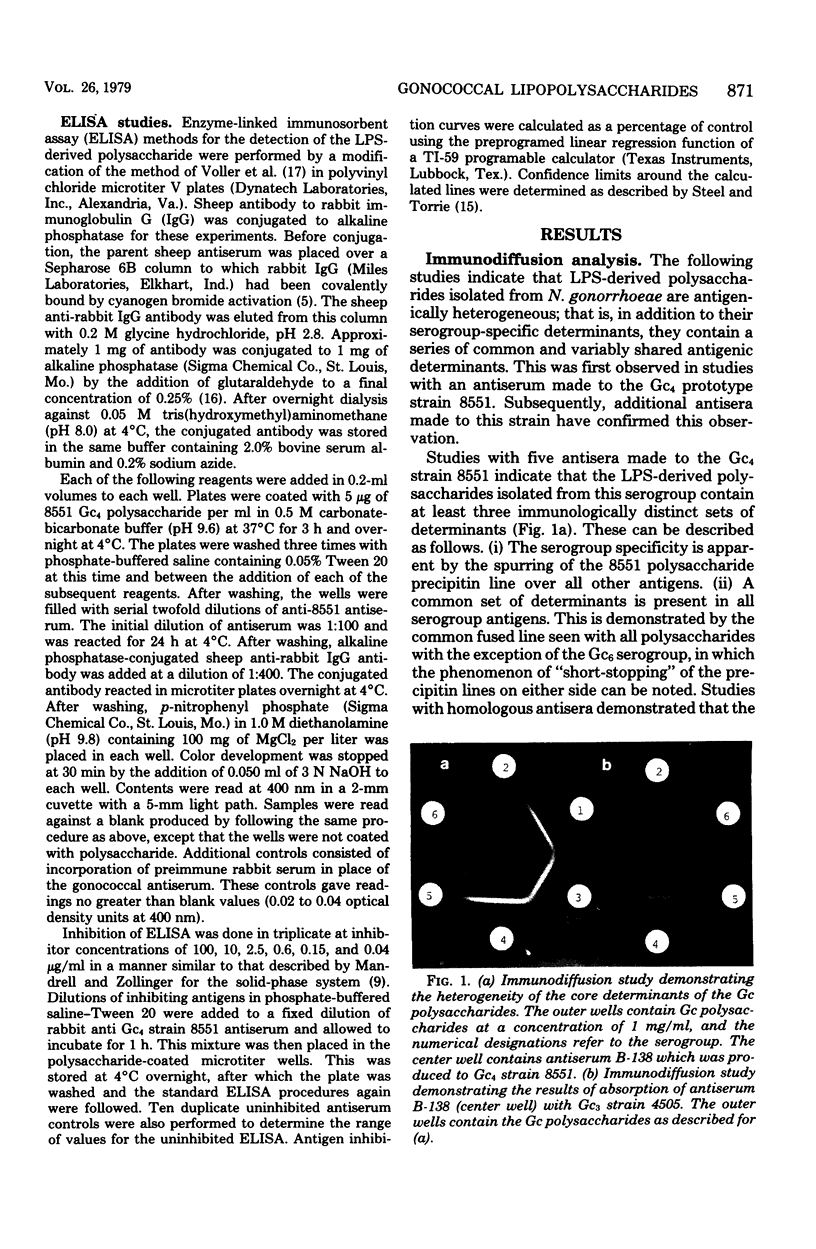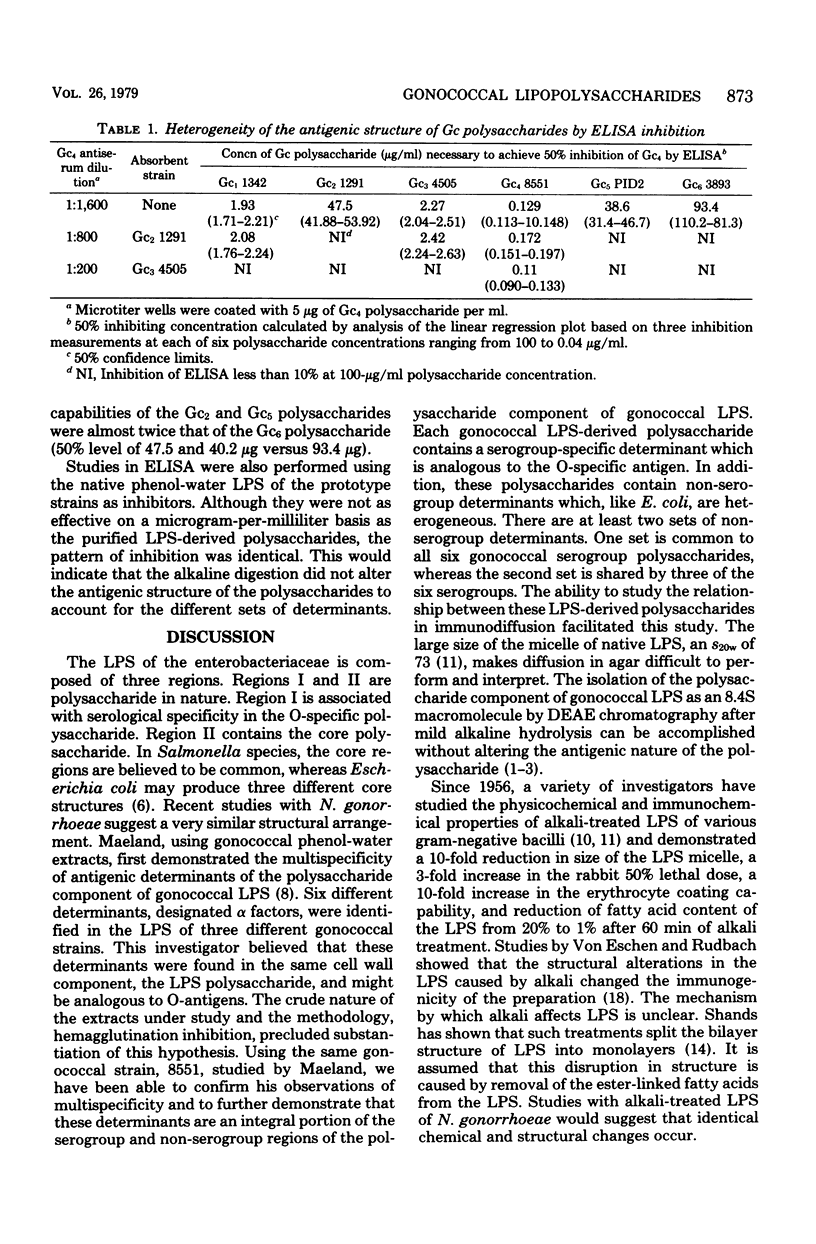Abstract
Studies of the antigenic structure of the polysaccharide component of gonococcal lipopolysaccaride (LPS) indicated that the non-serogroup antigen structure is antigenically heterogeneous. Immunodiffusion studies of Gc4 strain 8551 indicated that in addition to the Gc serogroup determinent, this polysaccharide contains two other sets of determinants, one which is shared with the other five Gc serogroups and a second which is shared by the Gc1 and Gc3 serogroups. Enzyme-linked immunosorbent assay (ELISA) studies confirmed the immunodiffusion, documented qualitative differences, and suggested that quantitative differences may exist in the common determinant from serogroup to serogroup. As measured by ELISA inhibition, native LPS showed the same antigenic arrangement as the purified LPS polysaccharides. Studies with LPS-derived polysaccharides from nonprototype strains in immunodiffusion gave results identical to the prototype strains. This antigen variation, although distinct from serogroup specificity, was related to the serogroup determinant.
Full text
PDF




Images in this article
Selected References
These references are in PubMed. This may not be the complete list of references from this article.
- Apicella M. A. Antigenically distinct populations of Neisseria gonorrhoeae: isolation and characterization of the responsible determinants. J Infect Dis. 1974 Dec;130(6):619–625. doi: 10.1093/infdis/130.6.619. [DOI] [PubMed] [Google Scholar]
- Apicella M. A. Serogrouping of Neisseria gonorrhoeae: identification of four immunologically distinct acidic polysaccharides. J Infect Dis. 1976 Oct;134(4):377–383. doi: 10.1093/infdis/134.4.377. [DOI] [PubMed] [Google Scholar]
- Ciznár I., Shands J. W., Jr Effect of alkali-treated lipopolysaccharide on erythrocyte membrane stability. Infect Immun. 1971 Oct;4(4):362–367. doi: 10.1128/iai.4.4.362-367.1971. [DOI] [PMC free article] [PubMed] [Google Scholar]
- Cuatrecasas P. Protein purification by affinity chromatography. Derivatizations of agarose and polyacrylamide beads. J Biol Chem. 1970 Jun;245(12):3059–3065. [PubMed] [Google Scholar]
- Lüderitz O., Staub A. M., Westphal O. Immunochemistry of O and R antigens of Salmonella and related Enterobacteriaceae. Bacteriol Rev. 1966 Mar;30(1):192–255. doi: 10.1128/br.30.1.192-255.1966. [DOI] [PMC free article] [PubMed] [Google Scholar]
- Maeland J. A., Kristoffersen T., Hofstad T. Immunochemical investigations on neisseria gonorrhoeae endotoxin. 2. Serological multispecificity and other properties of phenol-water preparations. Acta Pathol Microbiol Scand B Microbiol Immunol. 1971;79(2):233–238. [PubMed] [Google Scholar]
- Mandrell R. E., Zollinger W. D. Lipopolysaccharide serotyping of Neisseria meningitidis by hemagglutination inhibition. Infect Immun. 1977 May;16(2):471–475. doi: 10.1128/iai.16.2.471-475.1977. [DOI] [PMC free article] [PubMed] [Google Scholar]
- NETER E., WESTPHAL O., LUDERITZ O., GORZYNSKI E. A., EICHENBERGER E. Studies of enterobacterial lipopolysaccharides; effects of heat and chemicals on erythrocyte-modifying, antigenic, toxic and pyrogenic properties. J Immunol. 1956 May;76(5):377–385. [PubMed] [Google Scholar]
- Niwa M., Milner K. C., Ribi E., Rudbach J. A. Alteration of physical, chemical, and biological properties of endotoxin by treatment with mild alkali. J Bacteriol. 1969 Mar;97(3):1069–1077. doi: 10.1128/jb.97.3.1069-1077.1969. [DOI] [PMC free article] [PubMed] [Google Scholar]
- Rice P. A., Kasper D. L. Characterization of gonococcal antigens responsible for induction of bactericidal antibody in disseminated infection. J Clin Invest. 1977 Nov;60(5):1149–1158. doi: 10.1172/JCI108867. [DOI] [PMC free article] [PubMed] [Google Scholar]
- Shands J. W., Jr Evidence for a bilayer structure in gram-negative lipopolysaccharide: relationship to toxicity. Infect Immun. 1971 Aug;4(2):167–172. doi: 10.1128/iai.4.2.167-172.1971. [DOI] [PMC free article] [PubMed] [Google Scholar]
- TAUBER H., RUSSELL H. Amino compounds in lipopolysaccharides. J Biol Chem. 1960 Apr;235:961–964. [PubMed] [Google Scholar]
- Voller A., Draper C., Bidwell D. E., Bartlett A. Microplate enzyme-linked immunosorbent assay for chagas' disease. Lancet. 1975 Feb 22;1(7904):426–428. doi: 10.1016/s0140-6736(75)91492-0. [DOI] [PubMed] [Google Scholar]
- Von Eschen K. B., Rudbach J. A. Antibody responses of mice to alkaline detoxifield lipopolysaccharide. J Immunol. 1976 Jan;116(1):8–11. [PubMed] [Google Scholar]



